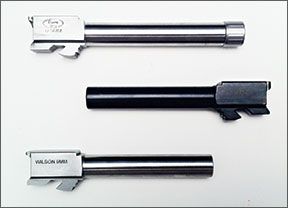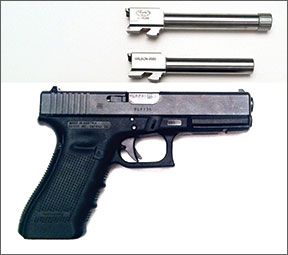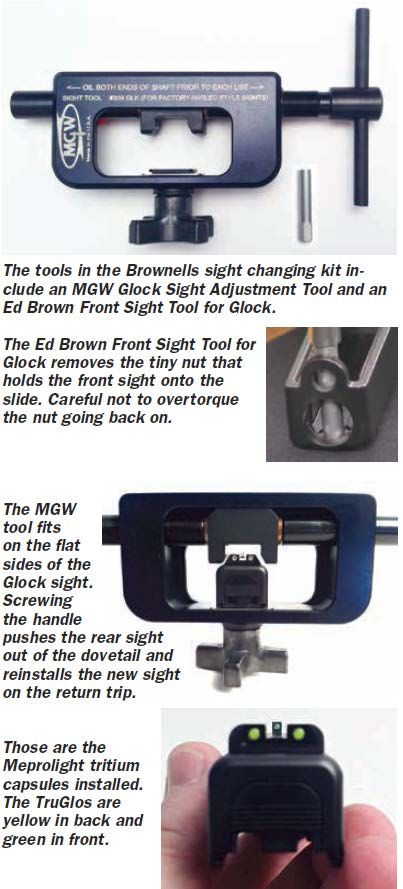Glock is renowned for building an always reliable pistol that has become the choice of many law-enforcement agencies and militaries across the world, and has already received a couple of top grades in Gun Tests. So, if Glock already makes a good pistol, why would we want to change it? First, we wanted to see if a Glock could be made even better with a few quick changes; second, to evaluate the aftermarket upgrades themselves and the bang for the buck they provide; and third, to see if personalizing a pistol is more an exercise in vanity than a measurable uptick in performance.

We took a look at a few of the upgrade and part options for Glocks, ranging from sights to triggers to a 22 LR conversion kit. The lucky Glocks to get the first-class treatment were one Gen 4 Model 17 and two Model 22s, one a Gen 4 and one a Gen 3 former police issue. We tested all of the parts individually to evaluate what difference they would make, considering ease of installation, performance difference, and price as the main grading points. All the parts were supplied by Brownells, and the stock numbers and pricing reflect recent citations rounded to the nearest dollar, but they could still vary.
Barrels
We started with the easiest of the upgrades to install. We had two barrels to test for the 9mm Luger Glock 17, the first being a match-grade 4.49-inch stainless tube made by Wilson Combat ($160, #965-397-017WB, Mfr Part: 379). Precision machined from 416 stainless steel in natural finish, it was slightly oversized in the lockup area to tighten slide-to-barrel fit. It offered conventional rifling that would shoot both lead and jacketed bullets. The manufacturer said it may require minor fitting.
The second unit was a 5.19-inch-long threaded stainless barrel from Storm Lake ($197, #842-000-096WB, Mfr. Part: GL179MM51901TT). It was threaded 1/2-28 and came with a thread-protecting cap. The Storm Lake is machined from 416R stainless steel hardened to 40-42 HRC. The cut-broached rifling accepts both jacketed and lead bullets, and the barrel was chambered for full case support. Our installation was drop in, but Storm Lake advises that minor fitting may sometimes be required.
The stock barrel had 3.75 inches of rifling and weighed 4.1 ounces. The Wilson Combat had the same 3.75 inches of rifling and weighed in at 4.0 ounces. The threaded Storm Lake barrel had 4.5 inches of rifling and weighed 4.5 ounces. Installation of the new barrels is as simple as removing and disassembling the slide, just like you would for cleaning, and then replacing the standard barrel with the new one.
Straight away we liked the look of the stainless on the black Glock, giving it a minimalistic two-tone appearance. The extended threads of the Storm Lake added even more to that cosmetic finish.

At the range, we shot our tightest group (1.9 inches) with the stock barrel using Federal JHP. The largest grouping of the day was 3 inches, with the stock barrel using Freedom RN and the match-grade barrel using both Tula and Freedom. Averaging all the groupings from each barrel, the Storm Lake proved to be the most accurate, averaging 2.2 inches over the three ammunitions. The stock barrel came in a close second, averaging 2.3 inches, and the Wilson match grade took the rear at a surprising 2.6-inch overall average.
The chronograph proved to be surprising as well. The stock barrel ran the slowest rounds of the day with Tula at 1108 fps, and averaged 1128 between the three ammunitions. The match grade averaged 1127 fps, while the threaded barrel averaged 1179 fps and had the fastest rounds of the day, averaging 1215 fps with the Freedom Blaster RN ammunition (FreedomMunitions.com).
Our Team Said: With all the numbers being calculated and averages weighed, testers preferred the threaded Storm Lake over the match-grade Wilson Combat. The Storm Lake was the most accurate overall, and it offered suppressor compatibility. Both the standard Glock sights and our new sights were blocked by the height of the suppressor, so we couldnt get accuracy and chrono data, but suppressor functionality was almost flawless.
Gun Tests Grade: A, Storm Lake Threaded
Gun Tests Grade: C, Wilson Combat
Trigger
Glock has a unique Safe Action system that makes their pistols safe and durable, including the factory-set trigger pull and trigger safety. Zev Technologies GlockWorx division offers an adjustable fulcrum trigger system that is said to improve the stock Glock trigger.
Brownells has all three variations of the fulcrum trigger set, the trigger and bar only ($140), the complete/drop-in trigger kit ($180), and the Ultimate kit. The trigger-only kit is just that, it contains only the trigger and trigger bar, requiring the use of the factory ejector block. The complete kit has a full trigger, bar, and ejector-block assembly ready to be dropped in along with a stainless firing-pin safety, race connector and all the springs. The trigger-only kit allows you to adjust both pre- and over-travel, while the complete and ultimate kits allow for trigger-pull weight adjustments as well. Installation will vary by kit as well. The Ultimate kit comes with all of the above and a skeletonized firing pin. We got the Ultimate kit ($250, #100-006-566WB, Mfr. Part: ZTFULULT4G9BLK) and promptly dropped it into our Glock 17.

Installing the trigger bar was relatively simple. Disassemble the frame by drifting out two pins above the trigger and one at the top of the back strap. The trigger assembly will lift out and can be replaced with the new Fulcrum trigger bar. Attaching the factory ejector block is as simple as changing one spring, and its unnecessary if you have either the complete or ultimate kit.
The next install is slightly more complex and can void the Glock warranty if not done by a Glock-certified armorer. To disassemble the slide to replace the firing pin, springs and firing-pin safety requires removing the back plate. Pressing the catch in front of the firing pin towards the barrel allows the back plate to slide off – be careful to cover the back with your finger as the firing pin and or plunger could pop out like the recoil spring in a 1911. Once the back plate has been removed, the firing pin assembly can be removed, then the plunger beside the firing pin can be removed. The ejector can be slid out of the side of the slide by pressing the firing pin safety down. Now the firing pin safety can be replaced with the stainless version provided by Glockworx and the plunger put back in place.
The firing pin and spring will require the collar from the original assembly to hold the spring in place. Once assembled, the firing pin assembly can be replaced and the back plate reinstalled. Glockworx provides two springs with the ultimate trigger kit, a standard and a lightweight trigger pull kit. The standard spring matches the factory at 5.5 pounds and the light spring is about 4.6 pounds. Overall assembly was quick, considering how many parts were changed. It took under an hour, and we were very careful and thorough to make sure everything was clean and set right. After the install, we dry-fired a few times and made sure to check that the reset and travel all worked right. Note: Adjusting pre- and overtravel too much can disable the pistol completely. Once we were sure everything was set right, we went to the range and had a fantastic time. The Fulcrum trigger was much smoother and crisper than the factory trigger, and the flat billet aluminum trigger was considerably more comfortable on the pad of your finger. The trigger safety on the Fulcrum sits flush with the rest of the trigger, so it wont wear out the tip of your finger – something we greatly appreciated after the first 50 rounds.
Our Team Said: The Ultimate Fulcrum trigger was the upgrade that produced the biggest difference in performance all by itself, increasing the accuracy of the Glock 17 from an average grouping of 2.3 inches down to 1.6 inches.
Gun Tests Grade: A
Sights
In past reviews of Glocks, weve criticized the standard Glock sights, with the squared U-shaped rear sights and front dots. To upgrade them, we ordered a Brownells Glock 17 Sight Upgrade Kit ($200, #080-000-919WB), which included a Meprolight (Kimber) ML-10224 Tru-Dot Night Sight System for Glock 17, 19, 22, 23, 31, 32, 33, 34, 35, 37, 38, 39; an MGW Glock Sight Adjustment Tool, and an Ed Brown Front Sight Tool for Glock. A disclaimer on the webpage for the kit notes, As indicated in the product descriptions, not all parts and accessories are official Glock products. Since we had the installation tools handy, we also ordered a set of TruGlo tritium fiber-optic Brite-Sites ($90, #902-000-107WB, Mfr. Part: TG131GT1Y), yellow rear and green front. We chose to put the TruGlo sights on the Glock 17 and the Tru-Dots on a G34 so that we could shoot them side by side.
With the Ed Brown Front Sight Tool for Glock ($20 sold separately, #087-017-001WB, Mfr. Part: 952) and the MGW Glock Sight Mover ($100 sold separately, #584-045-017WB, Mfr. Part: MGW309) for the rear sight, we started the switch with a disassembly of the slide to get access to the front sight. With the Ed Brown front sight tool and a small crescent wrench, we loosened the screw beneath the sight and removed it, then replaced the white dot with the new TruGlo front sight and tightened with the crescent wrench. Once the front sight was swapped, we hooked the slide into the MGW. The device came with some thin plates to raise the slide up the right height. We did not need them. The old sight drifted out with relative ease, going left to right pointed away from us. The new rear TruGlo sight did require some minor fitting with a file and a little more strength to slide in, but with the MGW tool, leverage was not a problem. We used the same process to put the Meprolite sights onto a factory Glock 34.
Despite the new TruGlo sights being fixed like the originals, we found them to be much clearer and easier to acquire and reacquire targets. We took to the range with the TruGlo sights installed, using all other original parts, and we cut our average group size down by almost half an inch, from 2.3 inches with the standard Glock to 1.9 inches with the TruGlo sights. We turned down the lights over the shooters, leaving the targets illuminated to check out how much the tritium would glow in the fiber-optic sights. The green front sight was quite bright, while the rear yellow sights were significantly dimmer, although still visible.
The Meprolight Tru-Dots provided an even more impressive change on the G34. We shaved just over a full inch off our average group size at 10 yards once we installed them.
Upgrading fixed sights can seem like a challenge to someone who hasnt done work on pistols previously, but with these tools and the simplicity of Glocks designs, this upgrade is a great place to start if you want to attempt a DIY project. You can drift the sights out with a punch, which will save $100 for the MGW tool, but you risk rupturing the tritium capsules. The MGW mover requires oil on the crankshaft, but it made drifting the dovetail sights in and out so easy we quickly misplaced our punch set. Our advice: Buy the tool and rent it out to folks in your gun club to cover its costs. Also, Ed Brown notes that on some of the 6-inch Glock slides, the hole at the bottom for the tool to fit through may have to be widened with a carbide drill bit. We did not have this problem, but we could see it being an issue for others should that hole not be wide enough. The complete process of changing sights on both the G17 and G34 was easy and made a big difference for how we performed.
Our Team Said: Overall, we found the TruGlo sights to be a nice upgrade and would recommend putting them in place of the standard non-tritium sights on any factory Glock.
Gun Tests Grade: A
Our Team Said: We likewise think the Meprolight Tru-Dot tritium sights to be a nice upgrade.
Gun Tests Grade: A
Items installed and tested by Austin Miller.Written and photographed by Austin Miller.
Videos of the trigger and sight installations appear on the Gun Reports YouTube page. More installation videos are available on the Brownells product pages. Coming up are installations of guide rods, lasers, 22 LR conversion kits, and balancing weights. GT






























